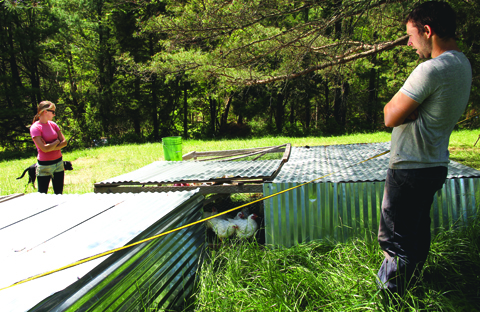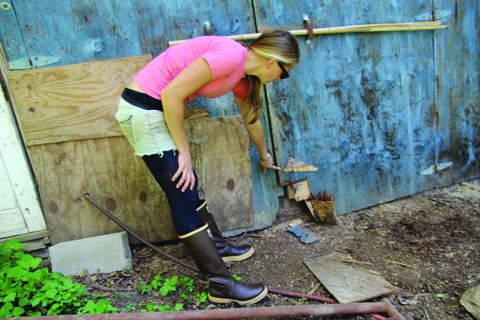
Joel Slezak and Erica Hellen have stepped up to the front lines of the local food movement. Joel, who grew up in Free Union with small farm experience, and Erica, who worked under organic food crusader Joel Salatin at his Polyface Farm in Augusta County, are now managing 33 acres they call the Free Union Grass Farm off Blufton Mill Road. They are raising chickens, ducks and beef that local buyers can have confidence were raised wholesomely and humanely and slaughtered responsibly.
They started in April 2010. “Our idea is to grow slowly.” They are on 13 acres of land owned by Slezak’s mother, Denise Zito, and they rent a 20-acre parcel next door to have enough land to farm. They come over every day to manage the farm from their home on Garth Road. It takes them an hour every morning to do their moving chores and fill waterers. They can reach some tanks with hoses, but some water must be carried.
In the winter Erica works for Hunt Country Corner Store and Joel does carpentry and painting.
As with Salatin’s method, it’s all about pasture management and daily rotations of the animals to keep them on fresh, rested land.
The egg-laying chickens lead the way. They have 65 laying hens, Barred Rocks and Anconas, known as dependable layers, that roost and lay in a shelter built on a farm wagon frame. The rest of the day they spend outside hunting bugs inside a circle of 164 feet of portable netting.
“Since November we’ve tracked every egg and it seems to be profitable,” said Slezak. “The egg market is growing. The chickens fertilize like crazy. They scratch aggressively and work manure into the soil. We manage completely with animals.” They do not own a tractor or bush hog. They shift the location of the wagon they call “the egg roll” with their pick-up truck.
“We’re going to try Golden Comets,” said Slezak. “They are supposed to be not skittish. We tried a mixed set of hens and found we lost some production. I’m thrilled about eggs.” They are getting about four dozen eggs a day this time of year. The layers are watered from a 50-gallon drum in the shelter that will hold five day’s supply. One of the complications with their goal of maximizing their pasture health and their method of moving their stock daily is maintaining the animals’ easy access to water.
In the next field are nine head of cattle, including five cows and one heifer.

“The beef is a slowly growing enterprise,” said Slezak. “Using a single strand of electric fence makes it important to have a tame herd. We take pride in how calm they are. We are with them everyday.” The breed is called British White, a relatively unknown breed that is moderately large, naturally hornless and considered very docile.
“The story is that it’s part of a royal herd that was brought to Virginia during a plague,” said Slezak. It is considered a dual-purpose breed, meaning reasonably good at both meat and milk production. They are white with black speckles across their chests, and black muzzles and tips on their ears.
“Flies are bad,” Slezak noted as he patted one cow. “We want to be natural and we also want the cattle to be comfortable. We wrestle with that all the time.”
The cattle were in a small pasture that the meat chickens had thoroughly scratched over the year before. The pasture grass was thick, lush and deep green. Slezak said his pastures are so healthy that they need only to feed hay to the cows for about about 60 days over the winter. They buy round bales and in the spirit of keeping things moving they allow the bales to stay on the same spot for only a day.

In another field are ducks. They are raising straight-run (meaning both boys and girls) Pekins that they get as day-old ducklings. They have five coops for ducks, each 12-by-12 feet, that they designed themselves. Ducks use 20-gallon waters and they need a secondary water source where they can dunk their heads. “We love them,” said Slezak. “They put down a lot of manure and they’ll eat weeds. Cows really only want grass.”
The duck market is strong. “We kill and pluck them. Restaurants can’t get enough of them. They are relatively good money. The market is competitive, though. We measure our labor. It takes about 30 minutes per bird for processing. Ducks don’t want to give up their feathers. Chickens are easy comparatively.”
The meat breed of chickens they are raising now is Cornish Cross, the most common breed for meat birds because, amazingly, they reach market weight in seven to nine weeks. “But they will gorge themselves,” Slezak explained.
They are thinking of going to a breed known as Poulet Rouge or with Freedom Rangers, a breed popular with other small farmers because they are thrifty and hardy outdoors and known for tastiness. But they are slower growing.
Chickens can be slaughtered as young as six weeks old, but usually it is at eight weeks and not later than 10 weeks. “It doesn’t taste as good as they get older,” Slezak said. The chicken pens are 10 by 12 feet and could be moved twice a day, he said. “It reduces their feed requirement by 30 percent to have them on grass,” he said.
Recently a bear had broken into their barn and eaten more than two dozen two-week-old chicks. It was the second time this year they have experienced losses to bears. They can tell it’s a bear by the heaps of scat left behind. And by the way stout wood structures are casually ripped apart.
The bears killed 50 birds in their first attack, among them eight ducks, and 27 in their second. “They got 40 birds that we reserved for a wedding. Raccoon and fox attacks we don’t worry about.” But the losses to the bears are directly affecting their income and represent the loss of all their effort raising the birds.
“We have a kill permit for the bears,” he said. “There’s two of them, a mom and a cub. The bears seem hungry. They have a taste for flesh.”
The bear broke through barricaded doors and tore down partition walls in the barn to get to the chicks. “The chicks get traumatized,” said Slezak. “You can feel their hearts racing. It really sucks.”
For two weeks they spent every night in their car at the farm waiting for a chance at the bears. “We’d hear them coming and we could hear them rattle the cages. Then we’d turn the lights on, but we couldn’t get a shot. It ain’t easy. That’s for sure.”
They had 75 chicks to start April and then had only 30 left. They had set out traps around the chicken pens for the bears, but the bears’ feet are big.
The problem of the bears goes on.

The farm is licensed by the state to process up to 20,000 birds a year. Slezak said they are hoping to process 2,000 birds this season, meaning between March and November. “The bears are cutting into that.”
They sell at the Charlottesville city market and to restaurants and other local stores. Typically they would kill 30 birds for the city market. “It really takes a long time to get ready for the market,” said Slezak. In total, they are selling roughly 75 birds a week.
They sell at Crozet Great Valu, providing the store about 12 birds a week. “They are good to us and they sell what they can get.” Chickens are available fresh or frozen. Duner’s restaurant in Ivy also buys from them.
“There’s a generation of people now who think that if it isn’t inspected by the government it isn’t safe. Our chickens never live in their own feces. If we had somebody get sick we would have to shut down. It doesn’t happen. They taste amazing. It’s an amazing product.”
For now they are plenty busy, but there are questions about their future and what they can afford. “We’re trying to figure out if we can farm in Albemarle or not. Maybe in the Valley. But you have to build a name for yourself. Our landowners around here can be very difficult. They want things trimmed up, but they don’t want them farmed.”
Slezak and Hellen are focused on the economics of the operation and do careful studies of their costs and efficiency. “We don’t want to be industrial farmers. People need to realize that they have to pay the cost of the food they eat. Factor in weather and predators. This is what it costs. It’s a lot of labor. We need an evolution of local producers who are feeding their own areas.”










